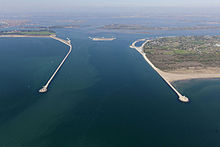

MOSE (Italian: Modulo Sperimentale Elettromeccanico, lit. 'Experimental Electromechanical Module') is a project intended to protect the city of Venice, Italy, and the Venetian Lagoon from flooding.
The project is an integrated system consisting of rows of mobile gates, installed on the seafloor at the Lido, Malamocco, and Chioggia inlets, that can be raised to temporarily seal off the Venetian Lagoon from the Adriatic Sea during acqua alta high tides. Together with other measures, such as coastal reinforcement, elevating of quaysides, and paving and improvement of the lagoon, MOSE is designed to protect Venice and the lagoon from tides of up to 3 metres (9.8 ft). As of 2023, the floodgates are raised for tides forecast to be more than 1.30 metres (4 ft 3 in).[1]
The Consorzio Venezia Nuova[note 1] is responsible for the work on behalf of the Ministry of Infrastructure and Transport – Venice Water Authority.[note 2] Construction began simultaneously in 2003.[3] On 10 July 2020, the first full test was successfully completed, and after multiple delays, cost overruns, and scandals resulted in the project missing both its 2018 completion deadline (originally a 2011 deadline)[4] and its 2021 deadline, and is now to be finished in 2025.[5][6][7] On 3 October 2020, the MOSE was activated for the first time in the occurrence of a high tide event, preventing some of the low-lying parts of the city (in particular piazza San Marco) from being flooded.[8] In 2020, the experts who had conceived a set of three floodgates separating the Adriatic Sea from Venice estimated that each year they would have to raise the floodgates 5 times. Within two years after the inaugural raising of the floodgates, MOSE was activated 49 times.[9]
- ^ Tara, Roopinder (13 April 2023). "Venice's Tide Barrier Has Already Cost 6 Billion Euros—Will it Work?". engineering.com. Retrieved 13 November 2023.
Operators in the MOSE control center, located in historic Arsenal, monitor tidal forecasts and start raising the barriers when the tide is predicted to rise above 130 centimeters (4.3 feet).
- ^ "full text, Law no. 798 of 1984". provveditoratovenezia.mit.gov.it. Retrieved 2 August 2023.
- ^ "MOSE Project". water-technology.net. Retrieved 3 October 2020.
- ^ "Venice tests its flood barrier system for the first time See: 4:01PM". www.telegraph.co.uk. 10 July 2020. Retrieved 3 October 2020.
- ^ Giuffrida, Angela (10 July 2020). "Venice's much-delayed flood defence system fully tested for first time". The Guardian. Retrieved 5 October 2020.
- ^ Roberto Giovannini (10 December 2017). "Venice and MOSE: Story of a failure". La Stampa. Retrieved 6 April 2018.
- ^ "Venice flood barriers planned completion now end of 2025". www.italianinsider.it. Retrieved 23 September 2022.
- ^ Silvestri, Manuel (3 October 2020). "Mose flood barrier finally holds the waters back for fragile Venice". Reuters. Retrieved 3 October 2020.
- ^ Horowitz, Jason (2 April 2023). "As Sea Levels Rise, the Savior of Venice May Also Be Its Curse". The New York Times.
Cite error: There are <ref group=note> tags on this page, but the references will not show without a {{reflist|group=note}} template (see the help page).